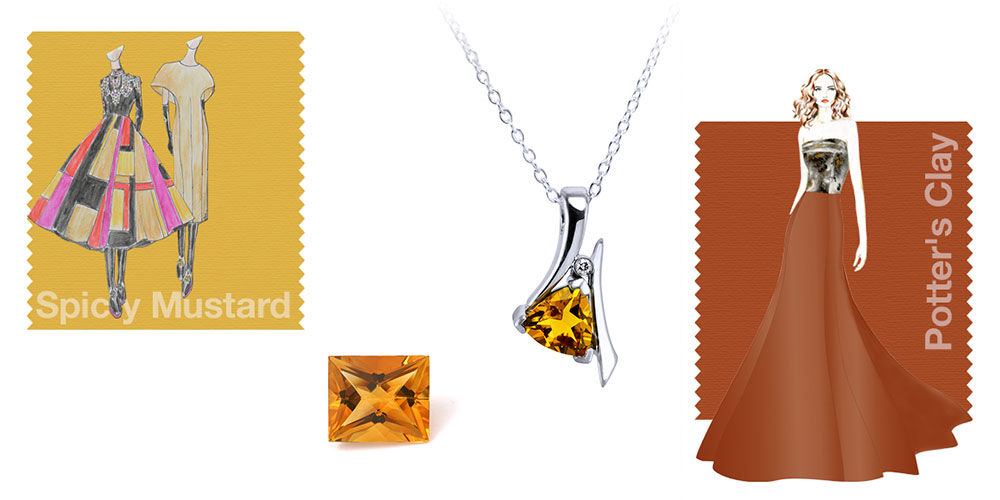Citrine
The world’s most popular quartz captures the warm glow of autumn

Citrine: the king of Quartz
By Carol Besler
The warm tones of Citrine are the perfect complement to the rich, earthy colors of fall and winter fashions. The gemstone’s mellow hues of cinnamon, umber and golden yellow exude the warmth of a glowing fire.
These colors make Citrine an ideal accessory for the deep, saturated earth tones of fall fashion, particularly Pantone’s top fall and winter colors: warm taupe, spicy mustard and potter’s clay. Such warm neutrals look best with yellow or rose gold, as does Citrine.
Citrine is one of many varieties of the mineral Quartz, which is available in more colors than any other mineral – Rose Quartz, Amethyst, Smoky Quartz, Aventurine and Praseolite are among the other varieties used in jewelry, and are all identifiable by their color. Citrine is the most common Quartz gem. It takes its name from the French word for lemon, even though the most prized Citrines are more brownish red or reddish orange (if it is too yellow, it’s simply called “lemon quartz”). The color comes from traces of iron.
Natural Citrine can be found in the Ural Mountains of Russia and in Madagascar. Most Citrine – that is, heat-treated Amethyst – comes from Brazil. Amethyst and Citrine colors can occur together in the same crystal in some gems in Bolivia. These unique stones are called Ametrine.
For years, Citrine was confused with the similarly colored Topaz, which is a completely different gem – Topaz is harder and heavier than Citrine, and because it has a higher refractive index, exhibits more fire in finer stones. But because of their similar color, the symbolism of the two stones is therefore intertwined.
Among the ancients and the mystics, Citrine is said to protect against snake venom, evil thoughts and heartache. It is thought to carry the power and energy of the sun and will not absorb negative energy. In addition to being the birthstone for November, it is also the gemstone of the 13th wedding anniversary.
1. An 18k hand made cocktail ring with a 21.16-carat “medicine wheel’ cut citrine by Larry Woods, made by Paula Crevoshay. With cognac diamonds. 2. Gemstone and diamond band by Michael John Jewelry, with a large citrine at front. 3. Citrine jewelry by August Mayer of Idar-Oberstein, Germany. Science
Natural Citrine is rare, so heat treatment is common and stable. Purple Amethyst, which is also a Quartz, is often heated to create the tawny shades of Citrine, and most Citrine is the result of this heat treatment, which is permanent. “Natural Citrines mainly occur in pale shades of color, says Karl Leyser of KS Jewelry International, Bangkok. “After heat treatment, however, they change to a more intensive color, with reddish tones,” he says. “But any kind of treatment of natural Quartz is no longer the main issue.
During the past few years synthetic Quartz has appeared more and more in the world markets.” Treatment does not affect the price of Citrine, which remains highly affordable.
Citrine has a hardness value of seven on the Mohs scale, which means it is scratch resistant enough to be set into rings, bracelets and any other jewelry that takes daily wear and tear. Quartz is the second most abundant mineral on earth, after Feldspar, and is therefore readily available, even in large sizes of up to 20 carats or more – and the price per carat does not rise dramatically for larger sizes. Citrine is therefore ideal for large cocktail rings or statement brooches and pendants.
Citrine is usually faceted in a variety of standard cuts, including cabochons, but large sizes also lend themselves to carvings or special cuts. Because of the availability and affordability of large gems, Citrine is often used as a center stone rather than as smaller accent stones, and is therefore often interpreted in dramatic statement pieces that add a lift to any winter wardrobe.
Top image: 1. One of Pantone’s top colors for fall 2016 and winter 2017 is spicy mustard. Design by Charles & Ron. 2. Citrine with a modified princess cut, courtesy of August Mayer, Idar-Oberstein, Germany. 3. Orchid pendant set with citrine by Mark Schneider. 4. One of Pantone’s top colors for fall 2016 and winter 2017 is Potter’s Clay. Design by Katherine Kung.



